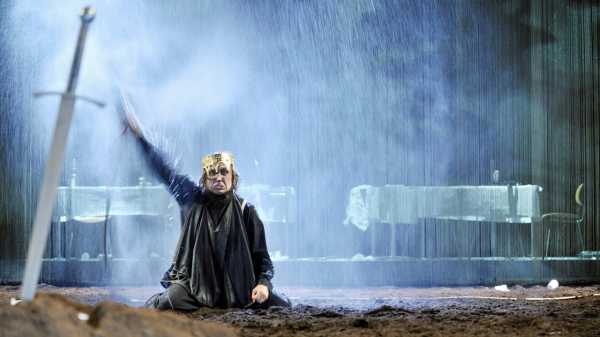
Thomas Ostermeier’s pedal-to-the-metal, German-language “Hamlet” has come to New York at last. It has been a fourteen-year wait: the Schaubühne Berlin production was first shown at the Hellenic Festival in Athens in 2008, and it seems to have travelled everywhere in the world but here. It’s the quintessential example of that period’s European, canon-mauling aesthetic—live video, microphones, a rock-and-roll-adjacent score, a commitment to making a giant mess—and it helped make Ostermeier’s international reputation.
Anticipation has therefore been sky high, particularly for “Hamlet” ’s star, Ostermeier’s chaotic muse, Lars Eidinger. Eidinger’s style is punk Muppet—a d.j. and actor whose kick-out-the-jams, Rabelaisian attitude infuses everything he does with vulgar electricity. New York last saw Eidinger onstage in the director’s “Richard III” in 2017, when he played the crookback king as a heavy-metal Gollum, spitting lyrics and iambs with equal venom. But Hamlet isn’t a “bottled spider,” as Richard is; he’s a famously contemplative, thoughtful guy. How can Eidinger, the theatre’s only cross between Cookie Monster and Joey Ramone, become the melancholy Dane?
Well, he has to get dirty to do it. Jan Pappelbaum’s set consists of an acre of mud (which Eidinger sometimes eats, in disgusting fistfuls), a rolling platform with a banquet table covered in beer cans and takeout containers, and a curtain made of silver chain, used as a projection surface. This “Hamlet” starts with an out-of-sequence bang: a partial rendition of the “to be or not to be” speech, delivered two acts early by a glum Hamlet into a handheld camera. The grieving prince, stunned by his father’s sudden death, films himself, his huge, grainy, black-and-white closeup filling the screen, as he frets about what, exactly, the dead might “perchance to dream.” (This soliloquy returns, like a damned spirit, three separate times, until Hamlet finally manages to finish it.) Then he turns the camera on the other actors—the screen shows us his paparazzo footage of his widowed mother, Gertrude (Jenny König in huge sunglasses), pushing him away, and his usurping, murderous uncle, Claudius (I saw Thomas Bading, in thick, Michael-Caine-in-the-seventies frames), looking guilty and afraid.
I saw this show in Berlin more than a decade ago, and I’ve been dreaming of it ever since. Specifically, I’ve been dreaming of the stunning second scene, which shows us Hamlet’s father’s burial in the rain. The tragic moment is made hilarious: A guy stands around misting everyone with a hose set to “fine spray,” as a clown-slash-gravedigger whoopsies the king’s coffin into the grave, falls in after it, jumps out, then counterproductively “helps” the mourners make their way across the wet earth. An officious Polonius (Robert Beyer) tries to keep an umbrella over Gertrude, but gets distracted; Hamlet hoodies his jacket over his head, so he looks like a big black thumb. The funeral turns into a muddy, slapstick bumble, and the digger hastily buries the whole mess—king, coffin, and somebody’s busted umbrella. So much for dignity, grief, hierarchy, poetry, and identity. This sequence contains Shakespeare’s larger message, which he tucks underneath all the talk of queens and princes: none of this matters. Worms will eat that body whether it is right-side-up or not.
If you are flipping through your edition of “Hamlet,” forget it. This scene isn’t in there, and, in Marius von Mayenburg’s German translation, many of the play’s most-underlined passages have been cut. (Mayenburg has also interpolated here and there, including some lyrics from Katja Ebstein’s 1980 Eurovision contest song, “Theater.”) “Hamlet” is such a hodgepodge, I often don’t miss lines when they’re gone—it’s rare to do the whole text—but Ostermeier chops out a ton, including marquee speeches like Polonius’s “To thine own self be true,” and a famous chat that Hamlet has with a skull. That’s because, for good and ill, we’re inside Hamlet’s skull, trapped in an antic brain that grows more ecstatic as it cuts loose from sanity. With only six people in the cast, characters, many doing double or triple duty, blur into each other—König, for instance, also plays Ophelia, toggling mid-scene between characters by pulling off and on a wig. This isn’t just thrift in casting: Hamlet flings both mother and girlfriend around like rag dolls. In Hamlet’s mind, all women are the same, and so, onstage, all women are the same.
Hamlet does start out pretending: Eidinger, when the character first decides to trick the court, mimics various impairments, putting on behaviors borrowed from Tourette sufferers, such as twitching and flapping and sticking out his tongue. This is uncomfortable, even offensive, to watch, but, as the play goes on, he reverts to the extreme, dirt-eating mania we’ve seen from the beginning of the show—his mind turns out not to have a “front” and a “back.” This Hamlet absolutely cannot tell a hawk from a handsaw (another speech that’s been kiboshed), and what the character describes as a ploy of “feigning” madness so his fratricidal uncle won’t try to kill him is clearly an unwell man telling himself lies. There’s none of Hamlet’s usual rueful, hard-won clarity here: in the middle of his sword fight with Laertes (Konrad Singer), he tries to hug the much shorter actor, grabbing at him like a kid who doesn’t know his own strength.
Hamlet is unleashed, unhinged, and ungovernable. Is Eidinger? Shakespeare’s play is about the difference between being and seeming, and there are times I lost track in this production of what was genuinely off-script. Even after fourteen years, the performance feels like touching a live wire. Certainly, the other actors didn’t look as though they knew exactly what Eidinger was going to do, which is (deliberately?) scary when he has a sword or a shovel in his hand. The supertitles can’t keep up with him, either. Some of his feral tricks seem planned; others, such as a fart at an opportune moment (he smiles into the audience, rapturous at pulling it off) and scattered comments in English (“All the single ladies, whoo!”), do not.
The ancient Greeks used to do this sort of thing. In festival competitions, after a series of tragedies, a playwright would present a satyr play, a burlesque in which a chorus of naughty, drunk, goat-like revellers would “invade” an existing myth. Something fancy and Homeric would be going on, and a bunch of dancing goat-bros would pratfall right in the middle of it, whirling their phalluses, and leering at the front row. Eidinger is our satyr, so it is only a matter of time before he gets his own googlies out, briefly having a little rummage during a extravagantly weird version of Hamlet’s play-within-a-play. He and Horatio put on a blood-smeared, spoof-regietheater version of a revenge melodrama called “The Mousetrap,” meant to “catch the conscience” of a twitchy Claudius. Hamlet, it turns out, has been in a fat suit all along—he strips it off to reveal panties, stockings, and heels; Horatio stuffs dirt down his undies to look priapic. I’m telling you, stop thinking about how it happens in the original.
Ostermeier’s work has changed since 2008, becoming more focussed on controlled images—recent creations include the highly disciplined, memoir-based productions “Returning to Reims” and Édouard Louis’s “History of Violence.” (These both came to St. Ann’s Warehouse, in 2018 and 2019 respectively.) He may have moved away from the splatter and mayhem, but his “Hamlet” doesn’t feel a minute out of date, partly because of its fine stagecraft (his video design works better than that of a hundred imitations I’ve seen since), partly because the older Eidinger gets the more his excessive behavior works in the part. In his early thirties, his tantrum-throwing, gun-shootin’ Hamlet alerted us to the way that some kinds of masculinity amount to an inescapable adolescence. In his mid-forties, though, his undimmed, if frightening, vitality points to a way out of the play’s guilty conundrums—chaos keeps you young.
The production’s Dionysiac madness is the type that intoxicates and energizes. In the original play, Hamlet is a “modern” man caught in a revenge drama; he keeps acting and thinking like a rational person in the face of ghosts and pirates and poison-dipped swords. How, Shakespeare asked, would a real mind grapple with these Gothic horrors? The result, and I speak here of every other “Hamlet” I have seen, is a bummer. Here, though, those horrors can’t compete with Hamlet’s own chaotic charisma.
Eidinger, like the satyr, simultaneously invades, ridicules, and exalts the theatrical effort, charging through the play like a bull in a Shakespeare shop. The same number of people die as ever, the plot hasn’t changed (much), but somehow Ostermeier’s version is liberating, ecstatic, and paradoxically joyful. When this Hamlet returns from the play’s mid-drama excursion to England (Claudius is going to have him killed there), he shows back up at Elsinore wearing a pink Hawaiian shirt. If I’d had one with me, I would have put it on, too. I could have sworn I’d spent the previous two hours running full-tilt down a beach. When do you get to go to a “Hamlet” and feel like you went on vacation? ♦
Sourse: newyorker.com






